
Pictures of Cyanobacteria:
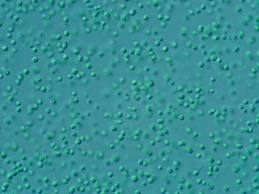

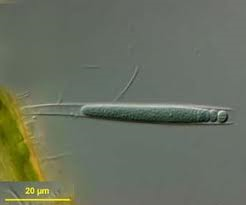
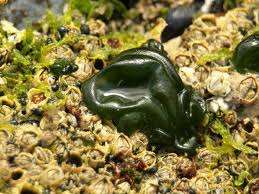

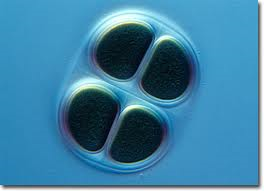
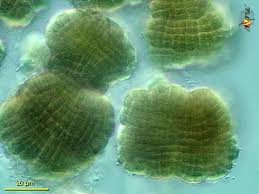
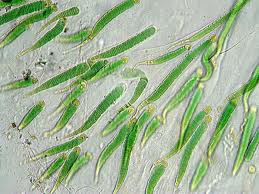
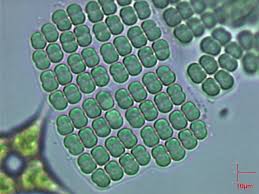

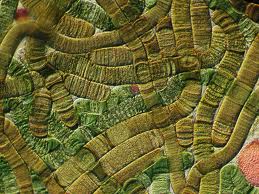
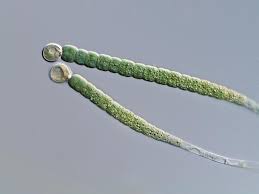


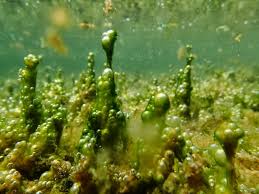
Characteristics of Cyanobacteria:
The phylum
Cyanobacteria (which means blue-green bacteria due to the bluish-green color
they often have) is one of the major phyla of bacteria. They are organisms with
a worldwide distribution, highly abundant in a wide range of ecosystems, such as
deserts, where they form crusts on the soil, or in the open sea, where millions
of tiny cells are part of the vast masses of water. They inhabit saline or
hypersaline water and freshwater, humid environments, and extreme cold and hot
deserts. Their main characteristic is their ability to perform photosynthesis
using chlorophyll, releasing oxygen in this process. Photosynthesis can be
carried out using water or hydrogen sulfide, so they are also abundant organisms
in sulfuric hot springs.
Cyanobacteria were the creators of chlorophyll, one of the essential molecules
for photosynthesis. All photosynthetic plants and eukaryotic algae live in
symbiosis with a cyanobacterium with reduced physiology, called plastid, which
is located inside plant cells. Symbiosis occurred during the early stages of the
evolution of the Eukaryota domain, when an ancestral unicellular Eukaryota was
able to live with a cyanobacterium inside its cellular cytoplasm. With
evolution, its descendants would eventually give rise to plants and algae, in
which this cyanobacterium, now called a plastid, is passed down from generation
to generation through seeds and spores. Thus, photosynthesis based on
chlorophyll has only arisen once in evolutionary history, in the lineage of
cyanobacteria, and this capacity has been transmitted to other lineages through
symbiosis of cyanobacteria with other organisms or through gene transfer in the
case of some bacteria.
Cyanobacteria are microorganisms whose cells measure only a few micrometers in
diameter but are larger than most other bacteria. The cytoplasm usually presents
recognizable structures such as carboxysomes (organelles containing the enzyme
that fixes CO2), glycogen granules, cyanophycin granules, polyphosphate
granules, gas vesicles, and sometimes thylakoids, flattened vesicles formed by
invagination of the plasma membrane where the molecular apparatus of
photosynthesis resides. In the absence of thylakoids, this machinery is located
in the cell membrane. The cell surface is composed, as in all gram-negative
bacteria, of a plasma membrane and an outer membrane, with a murein wall
(peptidoglycan) located between them.
The most common cyanobacteria are unicellular, spheroidal, sometimes aggregated
in a mucilaginous capsule, or forming simple filaments. The filaments may appear
aggregated in bundles, enveloped by mucilage, or sometimes are falsely branched
by filament fragmentation. There are also cyanobacteria that form filaments with
true branching. Between the cells of a filament, there is intimate communication
in the form of micropores, and there is also a degree of functional
specialization. The most notable difference is provided by heterocysts, special
cells that are only present in one lineage of cyanobacteria. Heterocysts appear
as larger cells with thickened walls interspersed in the filaments. Their walls
contain cellulose, the most abundant polymer in plant cell walls. Heterocysts
contain the nitrogen-fixing machinery, a process that is relatively incompatible
with photosynthesis and essential for protein formation in nitrogen-poor
environments. Another type of specialized cells are akinetes, cells that become
larger, with a thicker wall than vegetative cells, sometimes with small
protrusions, and with a granular cytoplasm due to the accumulation of a large
amount of cyanophycin, a reserve substance. They secrete a new fibrous layer
between the wall and the mucilaginous layers, and have a reduced metabolism,
acting as resistance propagules.
Cyanobacteria are generally photosynthetic organisms, but some live
heterotrophically, as decomposers, and some have a mixed metabolism.
Cyanobacteria were the first to perform a variant of photosynthesis that has
become predominant, and that has determined the evolution of the terrestrial
biosphere. This is oxygenic photosynthesis. Photosynthesis requires a reductant
molecule (an electron source), which in this case is the water molecule. When
taking the hydrogen from water, oxygen is released. The evolutionary and
ecological explosion of cyanobacteria billions of years ago produced the current
atmosphere with oxigen, laying the groundwork for the emergence of aerobic
metabolism and the radiation of organisms in the Eukaryota Domain. Thus,
cyanobacteria were responsible for changing the destiny and characteristics of
the entire Earth's crust.
Cyanobacteria share with various bacteria the ability to take nitrogen from the
air and reduce it to ammonium (NH4+), a form of nitrogen that all cells can
utilize. Autotrophs that cannot fix nitrogen must absorb nitrate (NO3-), which
is a scarce and limiting substance. The enzymes that perform nitrogen fixation
are the nitrogenases, which are inhibited by oxygen, making them incompatible
with photosynthesis. Therefore, in many cyanobacteria, the two processes are
separated in time, with photosynthesis occurring during daylight hours and
nitrogen fixation only at night. Some species have solved the problem by using
heterocysts, larger cells with a thickened cellulose wall that are responsible
for nitrogen fixation. Heterocysts lack photosystem II, so there is no oxygen
release, and nitrogenase can act without inhibition. Some cyanobacteria are
symbionts of plants such as ferns of the genus Azolla, or plants of the genus
Cycas or Gunnera, to which they supply nitrogen. Due to their abundance in
different environments, cyanobacteria are important for nutrient cycling,
incorporating nitrogen into the food chain, where they participate as primary
producers or decomposers.
Some cyanobacteria produce toxins and can poison animals inhabiting the same
environment or drinking the water where they inhabit. The phenomenon becomes
significant only when there is a bloom (a demographic explosion), which
sometimes occurs in fresh or brackish waters if temperature conditions are
favorable and nutrients, especially phosphorus, aboundant. The most frequently
implicated genera in blooms are Microcystis, Anabaena, and Aphanizomenon. The
physiological mechanisms of intoxication are varied, with toxins being both
cytotoxic (attacking cells), hepatotoxic (attacking the liver), or neurotoxic
(attacking the nervous system).
Cyanobacteria were the primary producers of the biosphere for at least 1.5
billion years, although for the past 300 million years various groups of
eukaryotic algae (diatoms, dinoflagellates, and haptophytes or
coccolithophorids) have gained importance. Cyanobacteria, through oxygenic
photosynthesis, flooded the atmosphere with oxygen about 2.5 billion years ago.
The ability to use water as an electron donor in photosynthesis evolved only
once in the common ancestor of all cyanobacteria. Geological data indicate that
this crucial event took place early in Earth's history, at least 2.45-2.32
billion years ago, and probably much earlier. There is evidence that life
existed 3.5 billion years ago, but the question of when oxygenic photosynthesis
evolved remains a subject of debate and research. Clear evidence suggests that
about 2 billion years ago, there was already a diverse biota of cyanobacteria,
which were the primary producers during the Proterozoic eon (2.5-0.543 billion
years ago), in part because the redox structure of the oceans favored
photoautotrophs and nitrogen fixation. At the end of the Proterozoic, they were
joined by green algae (phylum Chlorophyta), but it was not until the Mesozoic
era (251-65 million years ago) that the radiation of dinoflagellates,
coccolithophores, and diatoms reduced the prominence of cyanobacteria. Today,
cyanobacteria are still crucial in marine ecosystems as primary producers and
nitrogen fixers.
The following cladogram shows the evolutionary relationships of the 4 major
lineages of cyanobacteria:
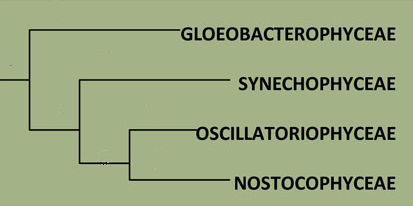
Phylum: Cyanobacteria